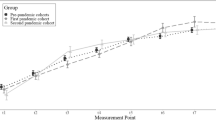Abstract
This paper explores the linkage between school quality, educational attainment and the wage gap. In a model of statistical discrimination based on both the quality and quantity of schooling, we show that lower-quality education can, on average, lead to lower human capital accumulation if agents anticipate future labor market discrimination. Because blacks in general have less access to good-quality schools compared to whites, this link provides a novel explanation for the differences in black–white educational attainment and the resulting wage gap.
Similar content being viewed by others
Notes
Because much of the literature on the black–white wage gap focuses on male income (to separate racial discrimination from gender-based discrimination), we refer to black and white males throughout the paper. However, as will be evident from the discussion below, the modeling framework is applicable more widely to any two groups of individuals that fit into the general story.
To eliminate concerns of units of measurement, suppose that all measurements are in terms of cost equivalence to some numeraire good, say, money.
This point addresses AC77’s critique of Phelps (1972) that assumes differences in both the mean and variance of innate ability between Blacks and Whites.
To solve this problem, we refer to the following Leibniz rule for differentiating an integral. For a well-defined function \(f(z, s_i)\), if \({\mathcal {I}}(s_i) = \int _{a(s_i)}^{b(s_i)}f(z, s_i){\mathrm{d}}z\), then
$$\begin{aligned} {\frac{{\mathrm{d}}{\mathcal {I}}}{{\mathrm{d}}s_i}} = \int _{a(s_i)}^{b(s_i)} {\frac{\partial \,f(z, s_i)}{\partial \,s_i}}{\mathrm{d}}z + f(b(s_i), s_i) {\frac{{\mathrm{d}}b}{{\mathrm{d}}s_i}} - f(a(s_i), s_i) {\frac{{\mathrm{d}}a}{{\mathrm{d}}s_i}} \end{aligned}$$Letting \(f(z, s_i) = [(1 - \gamma (\phi )){\bar{y}} + \gamma (\phi )s_i]{\mathrm{e}}^{-\theta (z-s)}\), \(a(s_i) = s + s_i\) and \(b(s_i) = \infty\),
$$\begin{aligned} {\frac{{\mathrm{d}}{\mathcal {I}}}{{\mathrm{d}}s_i}}&= \int _{s+s_i}^{\infty } \gamma (\phi ){\mathrm{e}}^{-\theta (z-s)}{\mathrm{d}}z - [(1 - \gamma (\phi )){\bar{y}} + \gamma (\phi )s_i]{\mathrm{e}}^{-\theta s_i} \\&= -\left. {\frac{\gamma (\phi )}{\theta }}{\mathrm{e}}^{-\theta (z-s)}\right| _{s+s_i}^{\infty } - [(1 - \gamma (\phi )){\bar{y}} + \gamma (\phi )s_i]{\mathrm{e}}^{-\theta s_i} \\&= {\mathrm{e}}^{-\theta s_i}\left( {\frac{\gamma (\phi )}{\theta }} - [(1 - \gamma (\phi )){\bar{y}} + \gamma (\phi )s_i]\right) \end{aligned}$$Setting equal to zero yields the interior solution (3) to the problem.
The MB is the discounted PV of increase in lifetime wages from an additional year of schooling, whereas the marginal cost is a one period opportunity cost in the form of forgone wages.
References
Aigner, D., and G. Cain. 1977. Statistical Theories of Discrimination in the Labor Market. Industrial and Labor Relations Review 30: 175–87.
Cameron, S., and J. Heckman. 2001. The Dynamics of Educational Attainment for Black, Hispanic, and White Males. Journal of Political Economy 109: 455–99.
Card, D., and A. Krueger. 1992a. Does School Quality Matter? Returns to Education and the Characteristics of Public Schools in the United States. The Journal of Political Economy 100(1): 1–40.
Card, D., and A. Krueger. 1992b. School Quality and Black–White Relative Earnings: A Direct Assessment. The Quarterly Journal of Economics 107(1): 151–200.
Carneiro, P., J. Heckman, and D. Masterov. 2005. Labor Market Discrimination and Racial Differences in Premarket Factors. Journal of Law and Economics XLVIII: 1–39.
Castello-Climent, A., and R. Domenech. 2008. Human Capital Inequality, Life Expectancy, and Economic Growth. The Economic Journal 118: 653–77.
Coate, Loury. 1993. Antidiscrimination Enforcement and the Problem of Patronization. The American Economic Review, 83:2, Papers and Proceedings of the Hundred and Fifth Annual Meeting of the American Economic Association. 92–98.
Couch, K., and M. Daly. 2002. Black–White Wage Inequality in the 1990s: A Decade of Progress. Economic Inquiry 40(1): 31–41.
Maxwell, N. 1994. The Effect on Black–White Wage Differences of Differences in the Quantity and Quality of Education. Industrial and Labor Relations Review 47(2): 249–64.
Neal, D., and W. Johnson. 1996. The Role of Pre Market Factors in Black–White Wage Differences. The Journal of Political Economy 104(5): 869–95.
O’Neill, J. 1990. The Role of Human Capital in Earnings Differences Between Black and White Men. The Journal of Economic Perspectives 4(4): 25–45.
Phelps, E.S. 1972. The Statistical Theory of Racism and Sexism. American Economic Review 62(4): 659–661.
U.S. Census Bureau. 2002. The Big Payoff: Educational Attainment and Synthetic Estimates of Work-Life Earnings. Current Population Reports, 23–210.
U.S. Census Bureau. 2013. Educational Attainment in the United States, March Current Population Survey 2013 Detailed Table 1. https://www.census.gov/data/tables/2013/demo/educational-attainment/cps-detailed-tables.html.
Author information
Authors and Affiliations
Corresponding author
Additional information
Publisher’s Note
Springer Nature remains neutral with regard to jurisdictional claims in published maps and institutional affiliations.
Rights and permissions
About this article
Cite this article
Ramamurthy, S., Sedgley, N. A Note on School Quality, Educational Attainment and the Wage Gap. Eastern Econ J 45, 415–421 (2019). https://doi.org/10.1057/s41302-018-00132-1
Published:
Issue Date:
DOI: https://doi.org/10.1057/s41302-018-00132-1




